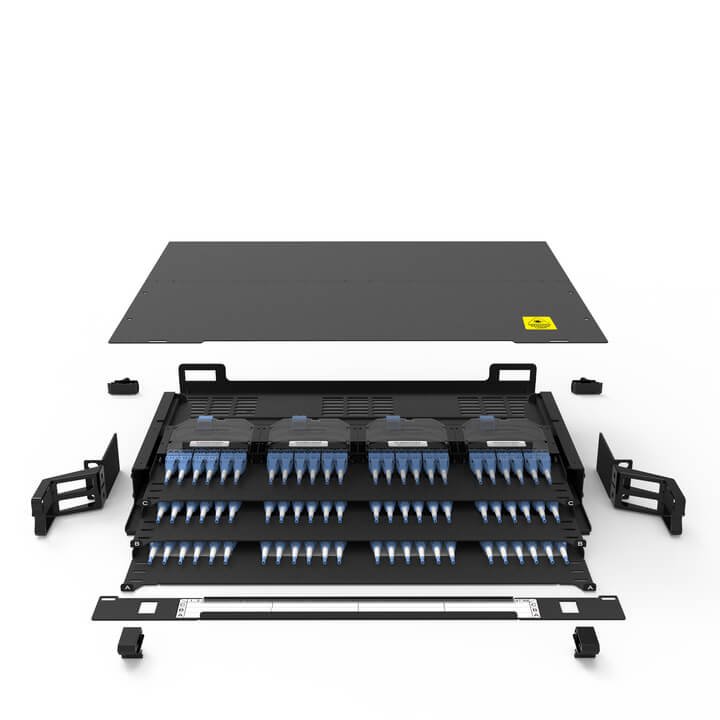What Data Center Networking?
Introduction to Data Center Networking

Data Center Patch Pannel
Data center networking refers to the complex interconnection of devices and infrastructure within a data center that enables efficient data storage, processing, and transmission. In today's digital-first world, data centers are the backbone of cloud services, enterprise systems, and large-scale applications. With the explosion of data traffic, an optimized, scalable, and secure network is critical to ensure minimal downtime and fast access to services and applications.
The goal of data center networking is to manage high traffic volumes while maintaining performance, security, and reliability. The ability to scale, adapt, and integrate new technologies is crucial as organizations increasingly rely on cloud solutions and real-time data processing.
The Components of Data Center Networking
Data center networks are made up of several core components, including:
- Switches and Routers:
Switches manage data traffic within the data center, directing packets of data to their correct destinations, while routers handle traffic between networks. Efficient routing ensures data takes the shortest path, minimizing latency. - Servers:
Servers are powerful machines responsible for running applications and managing large volumes of data. In a network, they process requests and send data across the network to other servers, storage, or end-users. - Storage Systems:
Data centers rely on robust storage solutions like Storage Area Networks (SANs) and Network-Attached Storage (NAS). These systems store and manage the massive amounts of data processed daily, with SANs providing block-level access and NAS offering file-level access. - Networking Software:
Advanced software solutions manage data flows, allocate resources, and enhance the virtualization and automation of network processes. SDN (Software-Defined Networking) and NFV (Network Functions Virtualization) are key technologies driving modern data center networking.
Data Center Network Architecture
There are several common architectures employed in data centers, each designed to maximize efficiency and reduce latency:
- Core Layer:
The backbone of the data center, providing fast and reliable transport of large volumes of data to both internal and external networks. - Aggregation Layer:
Also known as the distribution layer, this acts as the intermediary between access points and the core, aggregating traffic for more efficient processing. - Access Layer:
Connects end devices like servers to the network, ensuring direct and secure access. - Spine-Leaf Architecture:
A more modern design compared to the traditional three-tier approach, this architecture connects every access switch to every core switch, improving network speed and scalability. - Mesh Architecture:
Focuses on high availability by providing multiple redundant paths between network nodes, reducing the chance of failure.
Advanced Technologies in Data Center Networking
As data centers evolve, several advanced technologies are redefining how they operate:
- Virtualization and Automation:
Virtualization enables the creation of virtual versions of network components (e.g., virtual servers), improving efficiency by reducing physical hardware requirements. Automation reduces human error and accelerates tasks like deployment, configuration, and monitoring. - Software-Defined Networking (SDN):
SDN decouples the control plane from the data plane, allowing network managers to adjust resources dynamically based on real-time needs. This agility improves network efficiency and simplifies management. - Network Functions Virtualization (NFV):
NFV virtualizes entire classes of network functions, replacing proprietary hardware with software running on standard servers. This dramatically improves scalability and flexibility while reducing costs.
Challenges and Future Trends in Data Center Networking
While data center networking is foundational for modern IT infrastructure, it faces several challenges and opportunities:
- Scalability:
As demand for data continues to grow, networks must scale without compromising performance. New approaches, like the spine-leaf architecture, are addressing these needs by providing a more flexible, scalable alternative to legacy designs. - Security:
With increasing cyber threats, data center networks must implement robust security measures, including encryption, firewalls, and AI-driven threat detection to protect against breaches and maintain data integrity. - Performance:
High-performance networking ensures that data flows smoothly, preventing bottlenecks that could lead to service slowdowns or outages. Latency must be minimized, especially for data-intensive applications like AI, machine learning, and real-time analytics.
Future Trends:
- AI and Machine Learning:
Data centers are increasingly adopting AI to optimize traffic flows, predict network issues before they happen, and improve overall operational efficiency. - 5G Technology:
5G integration is expected to drastically improve network speed, capacity, and responsiveness, allowing data centers to handle the growing demand for data-heavy applications like IoT and video streaming. - Sustainability Practices:
As the environmental impact of data centers grows, there is a push towards greener technologies. Energy-efficient hardware, sustainable cooling systems, and the use of renewable energy sources are becoming essential.
Conclusion
Data center networking continues to evolve as new technologies emerge and data demands grow. From the adoption of AI and automation to the increasing role of 5G and sustainability, the future of data center networking is set to be faster, smarter, and more flexible. Maintaining a high-performance, scalable, and secure network will be crucial for businesses as they navigate the next generation of digital services.








